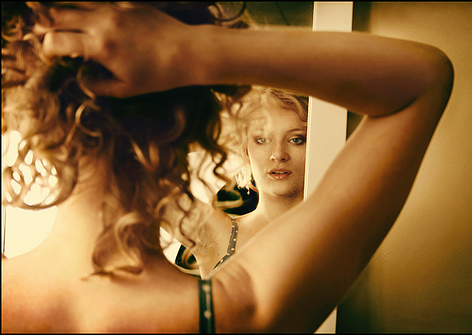 The seemingly ordinary act of looking in a mirror everyday can lead many people to feelings of disgust, shame, and sadness. As a result, they may avoid mirrors or, conversely, have trouble resisting the urge to check out how they look in any reflective surface. Therapists have been using mirrors as part of the treatment for eating disorders for years, but the research to support this has been mixed. A new study just came out examining mirrors in therapy via a randomized controlled trial.
The seemingly ordinary act of looking in a mirror everyday can lead many people to feelings of disgust, shame, and sadness. As a result, they may avoid mirrors or, conversely, have trouble resisting the urge to check out how they look in any reflective surface. Therapists have been using mirrors as part of the treatment for eating disorders for years, but the research to support this has been mixed. A new study just came out examining mirrors in therapy via a randomized controlled trial.
The study, to be published in Behavior Research and Therapy, was conducted at Mt Sinai School of Medicine in New York City. Teens and adults who were already receiving therapy for eating disorders were randomly assigned to extra sessions of mirror therapy or, as a means for comparison, extra sessions of more general body image therapy.
The mirror therapy lasted 5 sessions and the goal was to help “expose” patients to the strong negative emotions they feel while a therapist helps them better manage how they respond to these emotions. The patients were asked to stand in front of mirror, at first wearing more comfortable clothing and progressing in later sessions to more anxiety-provoking clothing (e.g. a bathing suit). They described themselves in detail while the therapist guided them towards less judgment and more acceptance of their body.
This use of an “exposure” has been a core tool of cognitive behavior therapy for decades, at first to treat other emotional difficulties like anxiety and then applied to eating disorders. In this study mirrors were used, but exposures can be done in many other ways (e.g. imagining something distressing in detail, exposure to certain foods that might otherwise trigger binge eating).
The Mt Sinai study found that patients who went through mirror therapy in addition to their existing treatment did better those who added a more general body image therapy. The mirror therapy patients felt more satisfaction with their bodies and experienced fewer eating disorder symptoms.
Is it worth the extra time and set-up for patients and therapist to add mirror therapy to eating disorder treatment? That’s not quite clear from this study. While mirror therapy seems helpful, we’ll need more research to see how it compares to other types of therapy that already address body image (like CBT-E) and to figure out what aspects of this 5-session mirror therapy are most helpful.
Have comments or questions? Discuss them on the facebook page or contact Dr. Gupta directly
Dr. Gupta is a professor at Barnard College of Columbia University and provides individual therapy at Tribeca Psychology
Stay up to date on the latest research: Follow the blog on twitter, like on facebook, or subscribe.
You may also be interested in reading:
Is your eating disorder therapy based on the latest scientific evidence?
Mindfulness: A tool you can use at home to reduce binge eating